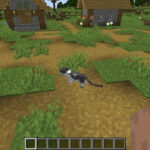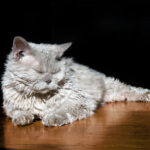The purr of a cat is one of the most recognizable and comforting sounds in the world, instantly associated with our feline companions. Many cat owners naturally assume that purring signifies happiness, a sign of a contented kitty. However, the reality of why cats purr is far more nuanced. Purring can occur in a range of emotional states, from pure bliss to times of stress or discomfort.
So, How Do Cats Purr, and what are all the reasons behind this fascinating feline phenomenon? Let’s delve into the science and secrets of the cat purr.
The Mechanism Behind the Purr: How Cats Create That Rumble
First, let’s unravel the mystery of how cats actually produce that distinctive, rumbling purr. Purring is a voluntary vocalization cats make with their mouths closed. It’s a unique process involving rapid muscle contractions in the larynx (voice box) and diaphragm. During breathing, air passes over the glottis, the opening between the vocal folds. These muscles around the glottis rapidly open and close, cycling at a rate of 20 to 30 times per second.
This rapid opening and closing of the glottis vibrates the vocal folds, creating the characteristic purring sound as the cat inhales and exhales. The diaphragm also plays a crucial role in sustaining this continuous vibration, resulting in the smooth, consistent purr we know and love.
Decoding the Purr: Why Do Cats Purr?
Now that we understand the mechanics, let’s explore the fascinating reasons behind cat purring. It’s a complex form of feline communication with a variety of meanings.
1. Purring for Contentment and Joy
The most commonly understood reason for purring is contentment. Cats often purr when they are feeling happy, relaxed, and secure. You’ll likely hear and feel your cat purring when they are in a positive emotional state, often accompanied by relaxed body language. Situations where a cat might purr with contentment include:
- Drowsiness: Drifting off to sleep in a cozy spot.
- Familiar Environments: Lounging in their favorite, safe space at home.
- Eating or After Meal Bliss: Enjoying a delicious meal or feeling satisfied afterward.
- Kneading Soft Surfaces: Engaging in that instinctive kneading behavior on a blanket or your lap.
- Basking in Sunlight: Soaking up the warmth of the sun in a sunny window.
- Curled Up on Your Lap: Receiving affection and warmth from their beloved human.
2. Purring as a Sign of Anxiety and Stress
Surprisingly, cats also purr when they are feeling anxious or stressed. This might seem counterintuitive, but purring can act as a self-soothing mechanism. Cats in stressful situations, such as a vet visit, may purr to help calm themselves down. You might observe a cat purring in anxious situations like:
- During Veterinary Examinations: Feeling nervous or uncomfortable at the vet’s office.
- Post-Vet Visit Recovery: Dealing with the stress of returning home from a clinic.
- Coping with Unfamiliar Situations: Adapting to new environments or changes.
In these instances, purring can be a way for a cat to manage their anxiety and regain a sense of calm. They may even pace while purring and meowing, displaying a mix of stress and self-soothing behaviors.
3. Purring as a Greeting
Cats often use short purrs as a form of greeting, both for humans and other cats. This is usually a friendly gesture, indicating a desire for positive interaction. You might hear greeting purrs when:
- You Arrive Home: Your cat welcomes you back with a purr.
- Meeting Other Friendly Cats: Cats greet each other in a familiar household.
- Mother Cats Approach Kittens: A mother cat purrs to reassure and bond with her young.
4. Purring for Attention and Interaction
Cats are clever communicators, and purring is sometimes used to solicit attention, particularly physical affection. They may purr to encourage you to pet them, give them a neck scratch, or simply engage with them. Attention-seeking purrs can occur when:
- Rubbing Against You: Weaving between your legs while purring to get your attention.
- Seeking Pets: Approaching you and purring to initiate petting.
- Interacting with Objects: Rubbing against furniture or toys while purring to mark territory and seek comfort.
5. Purring When Sick or in Pain
Another less obvious reason for purring is when a cat is unwell or experiencing pain. While it might seem odd, purring in these situations is believed to be a way for cats to self-heal and seek care. It’s thought that the low-frequency vibrations of a purr may promote bone healing and tissue regeneration. Cats might purr when:
- Feeling Ill: Experiencing sickness or discomfort.
- Injured or in Pain: Trying to soothe themselves and potentially promote healing.
- Nearing End of Life: Purring may offer comfort and a sense of peace.
While more research is needed, the potential therapeutic benefits of purring are a fascinating area of study.
Kitten Purring: Early Communication
Kittens are capable of purring remarkably early in life, sometimes as young as two days old. For young kittens, purring serves vital purposes:
- Nursing Communication: Kittens purr while nursing to communicate with their mother, signaling contentment and guiding her to them.
- Bonding with Mother and Littermates: Purring helps strengthen bonds within the feline family.
- Requesting Food and Care: Similar to adult cats, kittens may purr to solicit attention and care from their mother.
Context is Key: Understanding Your Cat’s Purr
To truly understand why your cat is purring, it’s essential to consider the context and observe their body language. Purring alone doesn’t tell the whole story.
- Happy Purr: A contented purr is usually accompanied by relaxed posture, slow blinks, and a soft, gentle sound.
- Anxious Purr: A stressed purr might be louder, accompanied by tense muscles, flattened ears, or dilated pupils.
- Greeting Purr: Often a short, soft trill combined with an upright tail and forward-facing ears.
By paying attention to the situation and your cat’s overall demeanor, you can become a purr expert and better understand their varied vocalizations.
Cat Purring FAQs
Why do cats purr when you pet them?
When a cat purrs as you pet them, it’s a clear sign of enjoyment! They are telling you they like the interaction and often encouraging you to continue. It’s a positive feedback loop that strengthens the bond between you and your feline friend.
Why do cats purr and knead?
Purring and kneading often go hand-in-hand and are linked to kittenhood behaviors. Kittens knead around their mother’s mammary glands to stimulate milk flow while purring contentedly. Adult cats may retain this behavior as a comforting, self-soothing action associated with positive emotional states.
Are cats always happy when they purr?
While purring is often associated with happiness, it’s not always the case. Cats purr for a variety of reasons, including stress, anxiety, and pain. To accurately interpret a purr, always consider the cat’s body language, the situation, and other behavioral cues.
References
Beaver, B. (2003) Feline Behavior: A Guide for Veterinarians. 2nd ed. Philadelphia: Saunders.
Brown, S and Bradshaw, J. (2014) ‘Communication in the domestic cat: within- and between-species’, in Turner, D. C. and Bateson, P. (eds) The Domestic Cat: the Biology of its Behaviour. 3rd ed. Cambridge University Press, pp. 37–59.
Tavernier, C. et al. (2020) “Feline vocal communication,” Journal of Veterinary Science, 21(1), pp. 1–17.
WRITTEN BY
Wailani Sung, MS, PhD, DVM, DACVBVeterinarian
Dr. Wailani Sung has a passion for helping owners prevent or effectively manage behavior problems in companion animals, enabling them to…


